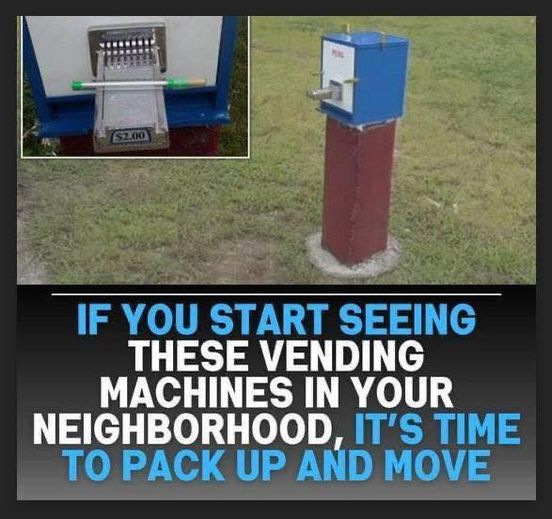Vending machines stocked with items such as crack pipes, condoms, and naloxone are becoming increasingly prevalent across the United States and Canada. These machines are part of a broader harm reduction strategy aimed at mitigating the health risks associated with drug use. This article explores the purpose of these vending machines, their geographical distribution, and the effectiveness of harm reduction approaches.
Purpose of Drug-Themed Vending Machines

The primary goal of these vending machines is to provide free, low-barrier access to essential harm-reduction supplies. Items such as crack pipes, fentanyl test strips, and naloxone (an overdose-reversing drug) are intended to reduce the risk of disease transmission and overdose deaths among drug users.1 Additionally, the vending machines offer condoms and other health supplies to promote safer practices.
The Concept of Harm Reduction

Harm reduction is a public health strategy designed to lessen the negative social and physical consequences associated with drug use. This approach recognizes that while drug use may continue, steps can be taken to reduce its harmful effects. Harm reduction strategies include providing clean syringes, supervised injection sites, educational resources, and – as we’re now seeing – vending machines.2
Examples Across the United States

New York City
In Brownsville, Brooklyn, New York City officials installed a “public health” vending machine that quickly became popular with local drug users. The vending machines, which dispense items like crack pipes and Narcan, were emptied within hours of their installation. Similar machines are planned for other parts of the city to help curb overdose deaths and promote safer drug use.
Las Vegas
Las Vegas has also implemented harm reduction vending machines, offering items such as sterile syringes and condoms. These machines aim to reduce the transmission of infectious diseases and provide safer options for drug users.3
Expansion in Ontario, Canada

Brantford, Ontario
In Brantford, Ontario, a vending machine offers harm reduction supplies such as HIV test kits, meth pipes, and naloxone.4 This machine, part of a pilot project, operates outside regular business hours to ensure 24/7 access. The goal is to reduce opioid-related hospital visits and deaths in the community.
Ottawa, Ontario
Four community health centers in Ottawa have installed vending machines stocked with sterile needles and crack pipes. These machines complement existing needle exchange programs and provide around-the-clock access to harm reduction supplies.
Harm Reduction in Vancouver

Vancouver’s Downtown Eastside is home to a vending machine that dispenses crack pipes and safe smoking kits.5 Managed by the Portland Hotel Society, the machine aims to prevent the spread of diseases like HIV by providing clean pipes. This initiative also helps undercut the black market for drug paraphernalia, ensuring a consistent and safe supply for users.
Benefits of Harm Reduction

Research indicates that harm reduction strategies can significantly reduce public health risks. For example, providing clean needles from vending machines and having supervised injection sites has been shown to decrease the transmission of HIV and hepatitis C. Additionally, access to naloxone has saved countless lives by reversing opioid overdoses.
Success Stories and Criticism

Programs like Insite in Vancouver, North America’s first sanctioned supervised injection site, have demonstrated the effectiveness of harm reduction. Studies show that such facilities can reduce public drug use, discarded needles, and crime without increasing local crime rates.6 However, these initiatives often face criticism from those who believe they enable drug use rather than addressing the root causes.
Addressing Public Concerns

Critics argue that providing free drug paraphernalia encourages drug use. However, evidence suggests that harm reduction does not increase drug consumption but instead makes it safer. Public health officials emphasize that the vending machine and safe site programs are designed to save lives and reduce the spread of disease. At the end of the day, the people who are using drugs are going to find a way to access them. Better to provide a sterile, safe environment for that to happen than to be at risk.
Economic Considerations

The financial benefits of harm reduction are substantial. Preventing new HIV or hepatitis infections can save taxpayers millions in healthcare costs. For example, each new HIV infection prevented saves approximately $15,000 per year in treatment costs. Additionally, reducing emergency room visits and other healthcare services leads to significant savings.
The Future of Harm Reduction

As harm reduction strategies continue to prove effective, more cities and countries are likely to adopt similar approaches. The expansion of vending machines offering health supplies is just one example of innovative solutions to complex public health challenges. Future initiatives may include more comprehensive services and increased collaboration between public health agencies and community organizations.
Conclusion

Vending machines offering crack pipes, condoms, and naloxone are becoming a common feature in urban landscapes across North America. These machines represent a practical and compassionate approach to harm reduction, offering essential supplies to those most at risk. While controversial, the evidence suggests that harm reduction strategies can significantly improve public health outcomes, making them a crucial component of contemporary drug policy.
